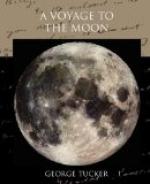“On this subject, however, I give no opinion. I only say, that it is not contradicted by the facts you have mentioned. The fluid and the solid parts settling down into a new sphere, might still retain nearly their former proportion: or, if the fragment took away a greater proportion of solid than of fluid, then the waters retiring to fill up the cavity, would leave parts bare which they had formerly covered. There are some facts which give a colour to this supposition; for most of the high mountains of the earth afford evidence of former submersion; and those which are the highest, the Himalah, are situated in the country to which the origin of civilization, and even the human species itself, may be traced. The moon too, we know, has much less water than the earth: and all those appearances of violence, which have so puzzled cosmogonists, the topsy-turvy position in which vegetable substances are occasionally found beneath the soil on which they grew, and the clear manifestations of the action of water, in the formation of strata, in the undulating forms it has left, and in the correspondent salient and retiring angles of mountains and opposite coasts, were all caused by the disruption; and as the moon has a smaller proportion of water than the earth, she has also the highest mountains.”
“But, father,” said I, “the diameter of the earth being but four times as large as that of the moon, how can the violent separation of so large a portion of our planet be accounted for? Where is the mighty agent to rend off such a mass, and throw it to thirty times the earth’s diameter?”
“Upon that subject,” said he, “the Lunarian sages are much divided. Many hypotheses have been suggested on the subject, some of which are very ingenious, and all very fanciful: but the two most celebrated, and into which all the others are now merged, are those of Neerlego and Darcandarca; the former of whom, in a treatise extending to nine quarto volumes, has maintained that the disruption was caused by a comet; and the latter, in a work yet more voluminous, has endeavoured to prove, that when the materials of the moon composed a part of the earth, this planet contained large masses of water, which, though the particles cohered with each other, were disposed to fly off from the earth; and that, by an accumulation of the electric fluid, according to laws which he has attempted to explain, the force was at length sufficient to heave the rocks which encompassed these masses, from their beds, and to project them from the earth, when, partaking of the earth’s diurnal motion, they assumed a spherical form, and revolved around it. And further, that because the moon is composed of two sorts of matter, that are differently affected towards the earth in its revolution round that planet, the same parts of its surface always maintain some relative position to us, which thus necessarily causes the singularity of her turning on her axis precisely in the time in which she revolves round the earth.”




